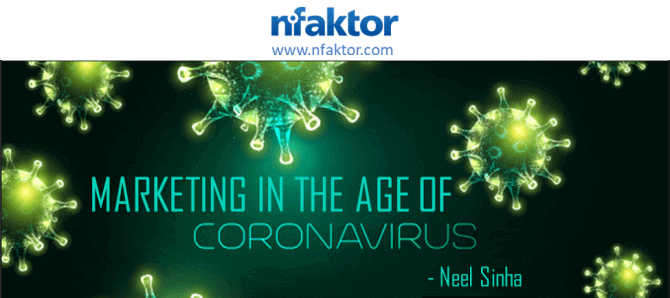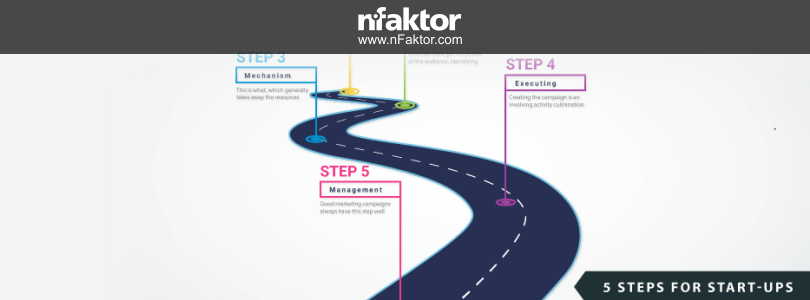11 focus areas to use your B2B marketing dollars.
Whatever said and done Corona Virus is an amazing ice breaker. Begin a communication with Corona Virus and even your unintended audience will sit-up and pay attention. With due respect and concern for those suffering or having suffered from the dreaded virus, because life must go on, here are my two bits on how the now christened COVID 19 is impacting marketing as we know it, and how we can adapt our marketing budgets to best leverage from the situation.
While corona virus has impacted the overall economy and it is on a downward spiral across sectors, it is clear that the Market is down because of the ‘Collective Mood’ of the ‘Overall Market’ not because a big bank has crashed or there is a finance pressure in some geography because of a war.
This ‘mood thing’ however is leading to an unprecedented situation, because the markets do not know how to tackle this. Handling mood swings are not the domain of finance geeks and economists. Then, who bells the cat. At a macro level, creating moods, has always been the job of marketers. This time around marketers would take this experience and possibly take the lead in turning around the ‘mood’ of the markets and the never before Nobel Prize for Marketing (not economics) will be awarded to a humble marketer somewhere – just a thought.
But Marketing, in itself has taken a hit. The biggest area where Marketing is starting to see a big slump is the contact programs like Events, Meet-ups, Roadshows sponsored seminars etc., This is where the 2nd big money was. (The first is obviously the TV Ads). Till now enterprises sponsored ads for stadium full of people and corporate events filled up very ball room of every 5 star property without a day to spare. Now all this going phut, all of a sudden, organizers, advertisers, CMOs have no clue what hit them and where and how to spend their parked budgets and generate leads for their sales folks.
To set another background, it is clear that market demands, though may get deferred for a short while is not really going to reduce, specially for Technology companies (Technology powers everything, every video that gets created on Corona virus gets stored a million times creating a need for million times more storage, speed and power requirement!! Research needs humongous servers powering AI applications!! Working from home needs data-centers powering cloud for VPNs and so on and so forth). So is the story with Healthcare (for obvious reasons), Maybe Automobile (People may start preferring personal drive than public transport) and then each industry powers the other and while business models may shift , maybe shopping malls to online retail, overall market demand would exist if not increase.
What next in marketing, is the ‘no brainer’. So much ‘no brainer’ that even the guy supplying nails to the event guys is suggesting the option of going digital and is figuring out online SEO courses that could teach him Nail-biting trends in digital marketing.
With so much of introduction, to address the ‘Why’ Digital Marketing in the age of Corona Virus, the question is How and What in Digital Marketing.
Here are some 11 pointers which could be strong contenders for the focus of enterprise marketers’ budgets.
- Greater focus on leisure content: In the near short future (hopefully short) lot of decisions are possibly going to be taken on the home dining tables – with working from home CXOs. In such scenarios, content that can compete to some extent with Netflix and occasional TV News on Corona Virus could have a greater chance of being consumed than regular B2B content.
- Mobile friendly Content: Content that is mobile friendly – larger fonts, maybe a short video, a gif, contextual, shareworthy will possibly have a greater reach and recall and mobile trained contet teams might be up for a raise.
- Online events such as Webinars: Webinars are a great format to explore in today’s context. They get you the best of three worlds – event kind of reach, digital kind of coverage and heavens kind of ROIs if done well. Read more on webinar strategies in my article on webinars.
- Social Media Marketing: A good place to be if there are enough creative brains to power a continuous stream of awesome content to compliment the Ad-budgets. With more budgets shifting to SMM, the differentiation would be the content.
- Email Marketing: For the same reasons as above, Email Marketing will only be effective if the CTA is powerful enough to entice an action, specially because the SPAM filters would be on an overdrive to ensure that all the emails powered by the Event Budgets do not burn-up your target audience’s hard drive.
- Whatsapp marketing: Whatsapp marketing is not marketing – it is intrusion. Possibly the way it has to be handled therefore has to be more like – your TG says “I want to read it on my mobile, can you share a pdf.” What I call hook marketing. In other words the bait has to be in an opt-in in another campaign like registering to receive a whitepaper or attending a webinar and then on Whatsapp takes over. Give a shot on building a team for Whatsapp friendly content.
- Content Syndication: Syndicating content with large publishers is expensive and does not always yield ROI class results but if there is a good content journey that drives the audience from top of the funnel towards down, the rewards could better. So if you are planning to include this in your campaign, focus on the content journey.
- Videos: With folks sitting at home (and working 😊) consumption of video as a content would surely surpass the recent peaks, it has seen. Enterprises should focus more on multimedia content, irrespective of being lifestyle videos or info-illustration and animation videos.
- Augmented Reality: AR has long been inducted by marketers as a marketing tool. In the absence of contact programs, this could see a greater adoption as a means for engagement with innovative interactions led renditions.
- Website based Marketing: This is a pick from the past. When websites came up there was a rush to get audiences to visit website, so much so, that website marketers ignored the very product they were supposed to sell. Guess the time has come back, and we borrow some dried up leaves from the technique and build a whole new perspective on how audiences consume websites. Interactivity, content gamification, gratification for engagement can now all happen at the virtual home of the enterprise (maybe a microsite), aways from the threat of the Corona.
- Tele-Calling: More monies available to marketers (savings from events etc.) focus may shift to getting more tele-sales. My take with Tele-sales would be to use as the last mile solution. Let the scenario for the tele-call be created by the digital campaigns and get the to prospect call the call center. If it is too much of outbound, my guess is people are going to get irritated in the middle of their tele and video conferences and prime videos 😊 and therefore becoming counter productive.
While humankind today is far more intelligent and capable to handle COVID19 like threats and things would come back to normalcy sooner than later, the scenario today could possibly lead to new disruptions in the way enterprises market their solutions and it would benefit all.
Let’s keep our fingers crossed and hope for the best!
Until then. Happy Marketing!
About the Author:
Neel Sinha is the Founder & Principal Consultant at nFaktor a B2B Marketing Agency. Nfaktor has offices in India and Singapore and works with leading enterprises on their marketing and Content Strategies across industries and geographies. Nfaktor has worked on multiple campaigns in the areas covered in the article specially in Content Syndication, Social Media Marketing, Website based Marketing and Webinars (with nearly 1000 webinars executed till date).
Read the author’s article on Webinars here.










